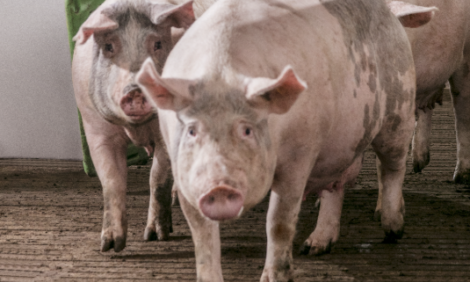



New cell line may lead to more reliable vaccine development to fight costly PRRS virus
Porcine reproductive and respiratory syndrome (PRRS) is a fast-mutating disease that will require producers to have vaccines that target specific variants and strains of the disease.The production of autogenous vaccines depends on the ability of scientists to isolate the virus, but sometimes that’s a tricky process. A new study from an Iowa State University researcher shows that a new cell line may offer a better alternative to the cell line most commonly used to isolate the PRRS virus. That could lead to more reliable processes for creating autogenous vaccines, but most autogenous vaccine producers would have to make dramatic changes to their processes in order to adopt the new cell line, said Jianqiang Zhang, associate professor of veterinary diagnostic and production animal medicine and lead author of the study.
The article was published this month in the peer-reviewed Journal of Clinical Microbiology.
PRRS is an infectious disease in pigs that costs pork producers hundreds of millions of dollars every year to contain. Currently available commercial PRRS vaccines don’t always provide effective protection to pigs due to high genetic and antigenic diversity among PRRS strains, Zhang said. So swine veterinarians often request diagnostic laboratories to isolate the virus from clinical samples to produce farm-specific autogenous vaccines.
Scientists have to grow the virus in a cell culture to isolate it successfully, and the most commonly used cell line for PRRS isolation is referred to as MARC-145, a cell line that originates in the kidneys of monkeys.
In the new study, Zhang analyzed a different cell line, referred to as ZMAC. The ZMAC cell line, derived from alveolar macrophages in pigs’ lungs, was developed by Dr. Federico Zuckerman at the University of Illinois and is a patented cell line. The Iowa State University Veterinary Diagnostic Laboratory obtained the ZMAC cell line from Aptimmune Biologics, Inc., a swine disease vaccine company that licensed the ZMAC cell line from University of Illinois. The study looked at the ability of the ZMAC line to culture the virus and then compared the results to the MARC-145 line. The study demonstrated that the ZMAC cell line can significantly improve the success rate for isolating the PRRS virus.
Using the ZMAC cell line resulted in successful isolation of viruses 57.6% of the time, while the MARC-145 cell line was successful 26.3% of the time, according to the findings.
“That’s potentially good for producers and veterinarians to produce farm-specific vaccines, but there’s a challenge because not all companies have adopted this ZMAC cell line,” Zhang said.
If scientists can’t isolate a particular virus variant, then they can’t produce autogenous vaccines to target that variant. So a cell line that successfully isolates the virus more often could be a valuable tool in producing more tailor-made vaccines.
“However, it is noteworthy that, when PRRS virus isolates obtained in ZMAC cell line were adapted to grow in MARC-145 cell line, only 57.3% of them grew and 42.7% did not grow”, Zhang said. “Considering that the vast majority of autogenous vaccine companies still rely on the MARC-145 cell line in their vaccine production systems, it may happen that some of them cannot produce autogenous vaccines even if a PRRS virus isolate is obtained in ZMAC cell line. It remains to be seen how readily they’ll adopt the use of the new ZMAC cell line.”
In the meantime, the research team notes that further study of these cell lines could fill in gaps in their understanding of why the ZMAC cells isolated the virus at a higher rate.
“Overall, a better PRRS virus isolation outcome can be achieved in ZMAC cells than in MARC-145 cells,” the study says. “The details of the mechanisms remain to be elucidated. It is suspected that the mechanisms are related to virus genetic diversity and the interaction between viral proteins and host cell receptors.”






